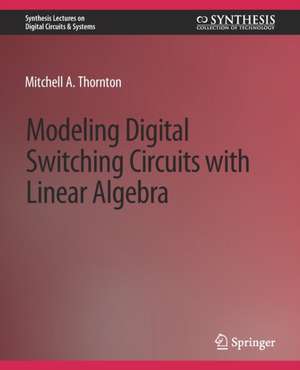Modeling Digital Switching Circuits with Linear Algebra: Synthesis Lectures on Digital Circuits & Systems
Autor Mitchell A. Thorntonen Limba Engleză Paperback – 14 mai 2014
Din seria Synthesis Lectures on Digital Circuits & Systems
-
 Preț: 391.61 lei
Preț: 391.61 lei -
 Preț: 464.75 lei
Preț: 464.75 lei -
 Preț: 353.86 lei
Preț: 353.86 lei -
 Preț: 382.95 lei
Preț: 382.95 lei -
 Preț: 279.80 lei
Preț: 279.80 lei -
 Preț: 234.87 lei
Preț: 234.87 lei -
 Preț: 317.52 lei
Preț: 317.52 lei -
 Preț: 191.30 lei
Preț: 191.30 lei -
 Preț: 279.80 lei
Preț: 279.80 lei -
 Preț: 279.80 lei
Preț: 279.80 lei -
 Preț: 234.87 lei
Preț: 234.87 lei - 19%
 Preț: 460.90 lei
Preț: 460.90 lei -
 Preț: 279.80 lei
Preț: 279.80 lei -
 Preț: 279.80 lei
Preț: 279.80 lei -
 Preț: 265.18 lei
Preț: 265.18 lei -
 Preț: 234.87 lei
Preț: 234.87 lei -
 Preț: 234.87 lei
Preț: 234.87 lei -
 Preț: 267.31 lei
Preț: 267.31 lei -
 Preț: 247.72 lei
Preț: 247.72 lei -
 Preț: 351.41 lei
Preț: 351.41 lei - 15%
 Preț: 548.10 lei
Preț: 548.10 lei -
 Preț: 416.01 lei
Preț: 416.01 lei -
 Preț: 351.41 lei
Preț: 351.41 lei -
 Preț: 191.30 lei
Preț: 191.30 lei -
 Preț: 383.71 lei
Preț: 383.71 lei -
 Preț: 191.30 lei
Preț: 191.30 lei -
 Preț: 264.20 lei
Preț: 264.20 lei -
 Preț: 191.30 lei
Preț: 191.30 lei -
 Preț: 234.87 lei
Preț: 234.87 lei -
 Preț: 279.80 lei
Preț: 279.80 lei -
 Preț: 454.53 lei
Preț: 454.53 lei -
 Preț: 234.87 lei
Preț: 234.87 lei -
 Preț: 429.59 lei
Preț: 429.59 lei -
 Preț: 234.87 lei
Preț: 234.87 lei -
 Preț: 234.87 lei
Preț: 234.87 lei -
 Preț: 247.72 lei
Preț: 247.72 lei -
 Preț: 351.41 lei
Preț: 351.41 lei -
 Preț: 450.71 lei
Preț: 450.71 lei -
 Preț: 191.30 lei
Preț: 191.30 lei -
 Preț: 383.71 lei
Preț: 383.71 lei -
 Preț: 191.30 lei
Preț: 191.30 lei -
 Preț: 234.87 lei
Preț: 234.87 lei -
 Preț: 191.30 lei
Preț: 191.30 lei -
 Preț: 279.80 lei
Preț: 279.80 lei
Preț: 264.41 lei
Nou
Puncte Express: 397
Preț estimativ în valută:
50.61€ • 52.63$ • 42.41£
50.61€ • 52.63$ • 42.41£
Carte tipărită la comandă
Livrare economică 13-27 martie
Preluare comenzi: 021 569.72.76
Specificații
ISBN-13: 9783031798665
ISBN-10: 303179866X
Ilustrații: XIII, 145 p.
Dimensiuni: 191 x 235 mm
Greutate: 0.29 kg
Editura: Springer International Publishing
Colecția Springer
Seria Synthesis Lectures on Digital Circuits & Systems
Locul publicării:Cham, Switzerland
ISBN-10: 303179866X
Ilustrații: XIII, 145 p.
Dimensiuni: 191 x 235 mm
Greutate: 0.29 kg
Editura: Springer International Publishing
Colecția Springer
Seria Synthesis Lectures on Digital Circuits & Systems
Locul publicării:Cham, Switzerland
Cuprins
Introduction.- Information as a Vector.- Switching Network Transfer Functions.- Simulation and Justification.- MVL Switching Networks.- Binary Switching Network Spectra.- Multi-valued Switching Network Spectra.- Implementation Considerations.- Summary.- Bibliography.- Author's Biography.- Index.
Notă biografică
Mitch?ornton is a Professor of Computer Science and Engineering and a Professor of Electrical Engineering at Southern Methodist University. Additionally, he serves as the Technical Director of the Darwin Deason Institute for Cyber Security, also at SMU. He was designated as the J. Lindsey Embrey Chair in Computer Science and Engineering in 2004 and as a Gerald Ford Research Fellow at SMU in 2005. His industrial experience includes employment at Amoco Research Center, E-Systems, Inc. (now L-3 Communications) and the Cyrix Corporation where he held a variety of engineering and technical positions. He has practiced as an independent professional engineer since 1993. His practice areas include all aspects of digital systems design and analysis, computer architecture, computer systems security, and embedded systems. He has published more than 200 technical articles, authored or co-authored five books, and is a named inventor on two U.S. patents and three patents pending. Mitch has consulted with and performed sponsored research for a variety of government and industrial organizations. His research interests include hardware computer security, electronic design automation, disaster and fault tolerance, and emerging technology. He is a licensed professional engineer in the states of Texas, Arkansas, and Mississippi. Mitch received the Ph.D. in computer engineering from SMU, M.S. in computer science from SMU, M.S. in electrical engineering from the University of Texas at Arlington, and B.S. in electrical engineering from Oklahoma State University
